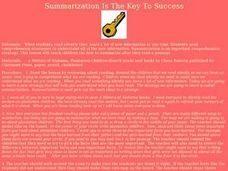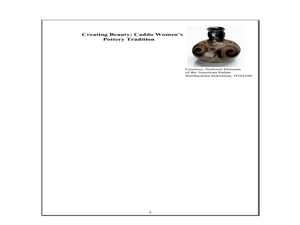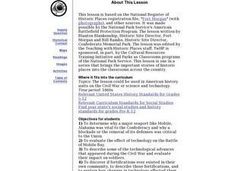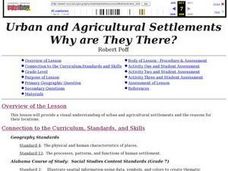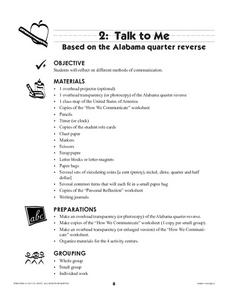Curated OER
The Battle of Horseshoe Bend: Collision of Cultures (54)
High schoolers discover the political and cultural conflicts that led to the Battle of Horseshoe Blend, Alabama, and evaluate historical maps of the Battle of Horseshoe Bend. They research American Indian cultures that were located in...
Curated OER
Wow! You're Eating Geography
Young scholars examine patterns of food producing areas, and identify foods that are grown locally, in the U.S., and around the world. They map and graph the major food crops of their local area, the U.S., and other countries, and...
Curated OER
Rain Forests: A Disappearing Act?
Students examine and locate rainforests on maps, and research the patterns of their destruction. They develop a bar graph of rainfall and temperature data, write a journal entry, and research the people, animals, and plants/products of...
Curated OER
Alabama Railroads: Maps as Historic Documents
Students identify historic documents and focus on the state of Alabama in 1860. This was during the time of the Reconstruction. The skills of comparison and analysis are used.
Curated OER
Summarization Is The Key To Success
Fourth graders exercise the strategies of silent reading and summarization to acquire new and important information from a text. They silently read and summarize page eighty-two in their "A History of Alabama" books. A review of...
Curated OER
Mapping Martin Luther King Jr.
Students examine geographic locations that were important in Martin Luther King Jr.'s life. They research Martin Luther King Jr., and create U.S. maps that show the locations important to him.
Curated OER
Scaling the Map
Middle schoolers practice determining map distances using the map scales. They discover how much an area represents on the map in relation to the actual area. They decide on the best place to build their cavern.
Read Write Think
Book Report Alternative: Rewind the Plot!
Have you ever looked for a new way to teach an old concept? Scholars thinking about the rising action of a story in a whole new perspective. However, Book Report Alternative: Rewind the Plot! challenges readers and allows for much...
Curated OER
Where is Everybody?
Students collect data from different grade levels at their school and develop thematic maps which show population density, and determine how this might affect the school and themselves in the future.
Curated OER
Indian Women in Texas History
Fourth graders study Indian women in Texas. In this US history lesson, 4th graders discuss what each Indian woman's contribution was by completing a timeline and table. Students examine the Caddo Women's pottery tradition...
Alabama Learning Exchange
Do You Have a Babushka?
Young scholars retrieve information about Patricia Polacco from selected sources. They classify information into prescribed categories on a concept map.
Curated OER
Grocery Aisle Signs and Locating Items
Students engage in instructional activity that is intended to help those who have mild disabilities with life skills. They focus upon the practice of shopping and finding items located in the grocery store. Students view a slideshow with...
Curated OER
The Formation and Value of Temperate Grasslands
Young scholars study the Temperate Grasslands biome of North America. They explain that it is an endangered ecosystem because the rich soils have been converted to farming in most areas. They view videos imbedded in this plan, then...
Curated OER
Fort Morgan
Students investigate how Mobile, Alabama was significant to the Confederacy during the Civil War. They analyze maps, read primary source documents, write a research paper on Civil War military technology, and explore the Fort Morgan...
Curated OER
Urban and Agricultural Settlements Why are They There?
Seventh graders identify types of human settlements, urban and agricultural, and determine geographic influence on why people settle where they did by use of maps and charts. They, in groups, identify the needs of a new settlement, which...
Curated OER
Talk to Me
Learners investigate communication techniques using variations in the tone of the voice, facial expressions, and gestures. The image of Helen Keller which appears on the reverse side of the Alabama quarter forms the basis of the lesson's...
Alabama Learning Exchange
Coral Reefs
Study explore coral reefs. In this coral reef lesson plan, 4th graders examine the physical structure of coral reefs. Students consider why coral reefs need to be protected and ways to protect them.
Curated OER
And the Rains Came Down: A South American Rainforest
Students examine the characteristics of a South American tropical rainforest. They analyze maps, develop graphs, listen to the book, The Great Kapok Tree, and create a rainforest mural.
Curated OER
The British Empire and the Royal Navy
Students locate on a map colonies belonging to the British Empire in 1775. They discuss the importance of colonies to the British Empire. They analyze the comparative sizes of period navies.
Alabama Learning Exchange
Biomes
Students research different biomes and find its climate and what plants and animals that can be found in them. For this biomes lesson students search the Internet for their information and fill out a biome chart.
Alabama Learning Exchange
This Is How We Roll!
Students research how roller coasters work. In this physics lesson, learners research the history of roller coasters and the safety factors in the design of a roller coaster on the website www.learner.org/exhibits/parkphysics. They...
Alabama Learning Exchange
Diverse Life Forms of the Ocean
Young scholars recognize marine organisms and differentiate between plankton and nekton. In this investigative instructional activity students create a concept map using their list of terms and study marine life forms.
Curated OER
Volcanoes:How Safe Are They?
Young scholars explore volcanoes, locate them on maps, record general information about volcanoes, and organize information on a fact sheet.
Curated OER
Winds of Change
Students investigate extreme weather patterns. In this current events lesson, students visit selected websites to study hurricanes and their causes. Students write reports on their findings.




